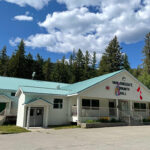Home »
The return of the Perseids
by Richard Nowell
You may have noticed more shooting stars in the sky over the past few weeks. There are still some Delta Aquarids from late July coming down, and we’re starting to see the beginning of the Perseids. This is a prime time of the year for meteors! Especially nice if you’re camping out, now that the mosquitoes are dying down.
The Perseids peak on Sunday, 12 August, from 12 to 14:30 UT. That would be early morning from 6 to 8:30 a.m. Mountain Daylight Savings Time (or 5 to 7:30 a.m. Pacific Daylight Savings Time). Which is too bad, since dawn starts to lighten the sky at 5:45 a.m. MDT, so you should be out at 5 a.m. to get a darker sky. The waning crescent Moon rises in the east around midnight, which will interfere a bit by making the sky glow.
We should get around 100 meteors per hour during those few hours. It’s debris from Comet Swift-Tuttle: loose packed cometary material, water and methane ices and sand, travelling at 59 kilometers per second.(That’s Mach 176, which makes a jet aircraft doing Mach 1 look like a snail, since Mach 1 is just .34 km/s. Rockets going to lower Earth orbit travel at a more appreciable 8km/s). The brighter ones are around one to two inches in diameter. Others are just specks and grains of sand.
The shower will be fairly active over three nights, from Aug 11 to Aug 13.
 Cranbrook already started with a meteor exploding and breaking up in the cloudy sky overhead on Thursday 2 Aug at 1:52 a.m. In the top composite video photo, the College of the Rockies video camera shows a fisheye view of the entire sky, with the horizon around the edges, and North at top. See our BC Meteor Network link at https://www.bcmeteors.net/component/content/article/1-latest-news/134-perseid-meteor-shower-begins-peaks-at-12-aug-2012.html . Click on the image there to download the large 1.2MB MP4 video file. (You’ll need Quicktime or something equivalent on your computer to view it.)
Cranbrook already started with a meteor exploding and breaking up in the cloudy sky overhead on Thursday 2 Aug at 1:52 a.m. In the top composite video photo, the College of the Rockies video camera shows a fisheye view of the entire sky, with the horizon around the edges, and North at top. See our BC Meteor Network link at https://www.bcmeteors.net/component/content/article/1-latest-news/134-perseid-meteor-shower-begins-peaks-at-12-aug-2012.html . Click on the image there to download the large 1.2MB MP4 video file. (You’ll need Quicktime or something equivalent on your computer to view it.)
Above your mail browser should play an animated GIF image, showing 25 video frames in slow motion, at two frames per second. First the fast meteor begins to heat the thin air around it into a glowing plasma, then when it hits higher density air it disrupts into a ball of incandescence, the outside layer breaking off, leaving pockets of glowing light debris behind it, the smaller denser interior shooting ahead, in turn disrupting under the tremendous deceleration and heating into a short glowing line, before slowly fading away. This one was fairly large in the sky For scale, notice the Moon is the glowing object near the bottom centre.
Unfortunately it didn’t hit the ground so we could collect it!
The Perseids are cometary meteors (ice/snow/loose sand) up to an inch or two in diameter, and these fast meteors burn up between 104 to 90km high in the atmosphere (none get past 75km) and these never hit the ground. Slower meteors can make it down a little further, the Dracinids come down to 70 km or so. It’s the rarer asteroid-type meteors composed of more solid rock or nickel/iron that are travelling slow enough (less than 23km/s) that do impact.
The International Meteor Organization predicts the k-Cygnids may peak Aug 13 as well, instead of the usual Aug 17, so the sky will be putting on quite a show that weekend. This is a smaller shower, just 3 meteors per hour, and they’re travelling slower, only 25km/s.
Check out: https://www.youtube.com/watch?v=6XTBrYWrey0
Rick Nowell, Physics Lab Tech
College of the Rockies
Top image from: NASA Science







